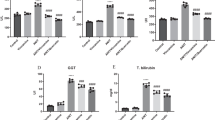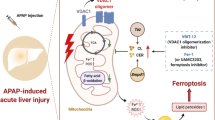Abstract
Encephalopathy is an important cause of morbidity and mortality in patients with severe hepatic failure and the mechanisms underlying hepatic encephalopathy are still not fully known. Considering that creatine kinase (CK) play a crucial role in brain energy homeostasis and is inhibited by free radicals, and that oxidative stress is probably involved in the pathogenesis of hepatic encephalopathy, we evaluated CK activity in hippocampus, striatum, cerebellum, cerebral cortex and prefrontal cortex of rats submitted to acute administration of carbon tetrachloride or acetaminophen. The effects of the administration of antioxidants, N-acetylcysteine (NAC) plus deferoxamine (DFX) in association, and taurine, were also evaluated. Our findings demonstrated that carbon tetrachloride inhibited CK activity in cerebellum; acetaminophen inhibited the enzyme in cerebellum and hippocampus. CK activity was not affected in other brain areas. The administration of NAC plus DFX reversed the inhibition of CK activity caused by carbon tetrachloride in cerebellum and by acetaminophen in cerebellum and hippocampus. On the other hand, taurine was not able to reverse the inhibition in CK activity. Although it is difficult to extrapolate our findings to the human condition, the inhibition of brain CK activity after hepatic failure may be involved in the pathogenesis of hepatic encephalopathy.




Similar content being viewed by others
References
Aksenov M, Aksenov M, Butterfield DA, Markesbery WR (2000) Oxidative modification of creatine kinase BB in Alzheimer’s disease brain. J Neurochem 74:2520–2527
Assis LC, Scaini G, Di-Pietro PB, Castro AA, Comim CM, Streck EL, Quevedo J (2007) Effect of antipsychotics on creatine kinase activity in rat brain. Basic Clin Pharmacol Toxicol 101:315–319
Bjerring PN, Eefsen M, Hansen BA, Larsen FS (2009) The brain in acute liver failure. A tortuous path from hyperammonemia to cerebral edema. Metab Brain Dis. doi:10.1007/s11011-008-9116-3
Bosoi CR, Rose CF (2009) Identifying the direct effects of ammonia on the brain. Metab Brain Dis. doi:10.1007/s11011-008-9112-7
Butterworth RF (2007) Neuronal cell death in hepatic encephalopathy. Metab Brain Dis 22:309–320
Carbonell T, Rama R (2007) Iron, oxidative stress and early neurological deterioration in ischemic stroke. Curr Med Chem 14:857–874
Castillo T, Koop DR, Kamimura S, Triadafilopoulos G, Tsukamoto H (1992) Role of cytochrome P-4502E in ethanol, carbon tetrachloride and iron dependent microsomal lipid peroxidation. Hepatology 16:992–996
Cigremis Y, Turel H, Adiguzel K, Akgoz M, Kart A, Karaman M, Ozen H (2009) The effects of acute acetaminophen toxicity on hepatic mRNA expression of SOD, CAT, GSH-Px, and levels of peroxynitrite, nitric oxide, reduced glutathione, and malondialdehyde in rabbit. Mol Cell Biochem. doi:10.1007/s11010-008-9961-8
Comim CM, Rezin GT, Scaini G, Di-Pietro PB, Cardoso MR, Petronilho FC, Ritter C, Streck EL, Quevedo J, Dal-Pizzol F (2008) Mitochondrial respiratory chain and creatine kinase activities in rat brain after sepsis induced by cecal ligation and perforation. Mitochondrion 8:313–318
Comporti M, Maellaro E, Del Bello B, Casini AF (1991) Glutathione depletion: its effects on other antioxidant systems and hepatocellular damage. Xenobiotica 21:1067–1076
Damiani CR, Benetton CA, Stoffel C, Bardini KC, Cardoso VH, Di Giunta G, Pinho RA, Dal-Pizzol F, Streck EL (2007) Oxidative stress and metabolism in animal model of colitis induced by dextran sulfate sodium. J Gastroenterol Hepatol 22:1846–1851
David S, Shoemaker M, Haley BE (1998) Abnormal properties of creatine kinase in Alzheimer’s disease brain: correlation of reduced enzyme activity and active site photolabeling with aberrant cytosol-membrane partitioning. Mol Brain Res 54:276–287
Desmond JE, Fiez JA (1998) Neuroimaging studies of the cerebellum: language, learning, and memory. Trends Cogn Sci 2:355–362
D’Esposito M (2007) From cognitive to neural models of working memory. Philos Trans R Soc Lond B Biol Sci 362:761–772
Diaz-Munoz M, Tapia R (1989) Functional changes of brain mitochondria during experimental hepatic encephalopathy. Biochem Pharmacol 38:3835–3841
Di-Pietro PB, Dias ML, Scaini G, Burigo M, Constantino L, Machado RA, Dal-Pizzol F, Streck EL (2008) Inhibition of brain creatine kinase activity after renal ischemia is attenuated by N-acetylcysteine and deferoxamine administration. Neurosci Lett 434:139–143
El Idrissi A, Trenkner E (1999) Growth factors and taurine protect against excitotoxicity by stabilizing calcium homeostasis and energy metabolism. J Neurosci 19:9459–9468
Ganey PE, Luyendyk JP, Newport SW, Eagle TM, Maddox JF, Mackman N, Roth RA (2007) Role of the coagulation system in acetaminophen-induced hepatotoxicity in mice. Hepatology 46:1177–1186
Grypioti AD, Theocharis SE, Papadimas GK, Demopoulos CA, Papadopoulou-Daifoti Z, Basayiannis AC, Mykoniatis MG (2005) Platelet-activating factor (PAF) involvement in acetaminophen-induced liver toxicity and regeneration. Arch Toxicol 79:466–474
Halim AB, el-Ahmady O, Hassab-Allah S, Abdel-Galil F, Hafez Y, Darwish A (1997) Biochemical effect of antioxidants on lipids and liver function in experimentally induced liver damage. Annu Clin Biochem 34:656–663
Hughes BP (1962) A method for estimation of serum creatine kinase and its use in comparing creatine kinase and aldolase activity in normal and pathologic sera. Clin Chim Acta 7:597–604
Jamshidzadeh A, Baghban M, Azarpira N, Bardbori AM, Niknahad H (2008) Effects of tomato extract on oxidative stress induced toxicity in different organs of rats. Food Chem Toxicol 46:3612–3615
Jost CR, Van der Zee CE, Zandt HJ, Oerlemans F, Verheij M, Streijger F, Fransen J, Heerschap A, Cools AR, Wieringa B (2002) Creatine kinase B-driven energy transfer in the brain is important for habituation and spatial learning behaviour, mossy fibre field size and determination of seizure susceptibility. Eur J NeuroSci 15:1692–1706
Khuchua ZA, Qin W, Boero J, Cheng J, Payne RM, Saks VA, Strauss AW (1998) Octamer formation and coupling of cardiac sarcomeric mitochondrial creatine kinase are mediated by charged N-terminal residues. J Biol Chem 273:22990–22996
Kuiyama K (1980) Taurine as a neuromodulator. Fed Proc 39:2680–2684
Lauterburg BH (2002) Analgesics and glutathione. Am J Ther 9:225–233
Lowry OH, Rosebough NG, Farr AL, Randall RJ (1951) Protein measurement with the Folin phenol reagent. J Biol Chem 193:265–275
Mansour MA (2000) Protective effects of thymoquinone and desferrioxamine against hepatotoxicity of carbon tetrachloride in mice. Life Sci 66:2583–2591
Mattarozzi K, Campi C, Guarino M, Stracciari A (2005) Distinguishing between clinical and minimal hepatic encephalopathy on the basis of specific cognitive impairment. Metab Brain Dis 20:243–249
Monfort P, Muñoz MD, Felipo V (2005) Molecular mechanisms of the alterations in NMDA receptor-dependent long-term potentiation in hyperammonemia. Metab Brain Dis 20:265–274
Pawa S, Ali S (2004) Liver necrosis and fulminant hepatic failure in rats: protection by oxyanionic form of tungsten. Biochim Biophys Acta 1688:210–222
Rama Rao KV, Jayakumar AR, Norenberg DM (2003) Ammonia neurotoxicity: role of the mitochondrial permeability transition. Metab Brain Dis 18:113–127
Recknagel RO, Glende EA, Dolak JA Jr, Waller RL (1989) Mechanisms of carbon tetrachloride toxicity. Pharmacol Ther 43:139–154
Richards DA, Lemos T, Whitton PS, Bowery NG (1995) Extracellular GABA in the ventrolateral thalamus of rats exhibiting spontaneous absence epilepsy: a microdialysis study. J Neurochem 65:1674–1680
Riordan SM, Williams R (1997) Treatment of hepatic encephalopathy. N Engl J Med 337:473–479
Ritter C, Reinke A, Andrades M, Martins MR, Rocha J, Menna-Barreto S, Quevedo J, Moreira JC, Dal-Pizzol F (2004a) Protective effect of N-acetylcysteine and deferoxamine on carbon tetrachloride-induced acute hepatic failure in rats. Crit Care Med 32:2079–2084
Ritter C, Andrades ME, Reinke A, Menna-Barreto S, Moreira JC, Dal-Pizzol F (2004b) Treatment with N-acetylcysteine plus deferoxamine protects rats against oxidative stress and improves survival in sepsis. Crit Care Med 32:342–349
Ritter C, Cunha AA, Echer IC, Andrades M, Reinke A, Lucchiari N, Rocha J, Streck EL, Menna-Barreto S, Moreira JC, Dal-Pizzol F (2006) Effects of N-acetylcysteine plus deferoxamine in lipopolysaccharide-induced acute lung injury in the rat. Crit Care Med 34:471–477
Schlattner U, Wallimann T (2000) Octamers of mitochondrial creatine kinase isoenzymes differ in stability and membrane binding. J Biol Chem 275:17314–17320
Schnyder T, Gross H, Winkler H, Eppenberger HM, Wallimann T (1991) Crystallization of mitochondrial creatine kinase. Growing of large protein crystals and electron microscopic investigation of microcrystals consisting of octamers. J Biol Chem 266:5318–5322
Slater TF, Cheeseman KH, Ingold KU (1985) Carbon tetrachloride toxicity as a model for studying free-radical mediated liver injury. Philos Trans R Soc Lond B Biol Sci 311:633–645
Smith SW, Howland MA, Hoffman RS, Nelson LS (2008) Acetaminophen overdose with altered acetaminophen pharmacokinetics and hepatotoxicity associated with premature cessation of intravenous N-acetylcysteine therapy. Ann Pharmacother 42:1333–1339
Streck EL, Scaini G, Rezin GT, Moreira J, Fochesato CM, Romão PR (2008a) Effects of the HIV treatment drugs nevirapine and efavirenz on brain creatine kinase activity. Metab Brain Dis 23:485–492
Streck EL, Amboni G, Scaini G, Di-Pietro PB, Rezin GT, Valvassori SS, Luz G, Kapczinski F, Quevedo J (2008b) Brain creatine kinase activity in an animal model of mania. Life Sci 82:424–429
Streijger F, Jost CR, Oerlemans F, Ellenbroek BA, Cools AR, Wieringa B, Van der Zee CE (2004) Mice lacking the UbCKmit isoform of creatine kinase reveal slower spatial learning acquisition, diminished exploration and habituation, and reduced acoustic startle reflex responses. Mol Cell Biochem 256/257:305–318
Streijger F, Oerlemans F, Ellenbroek BA, Jost CR, Wieringa B, Van der Zee CE (2005) Structural and behavioural consequences of double deficiency for creatine kinases BCK and UbCKmit. Behav Brain Res 157:219–234
Sturman JA (1993) Taurine in development. Physiol Rev 73:119–147
Suzuki WA (2007) Making new memories: the role of the hippocampus in new associative learning. Ann NY Acad Sci 1097:1–11
Szymonik-Lesiuk S, Czechowska G, Stryjecka-Zimmer M, Słomka M, Madro A, Celiński K, Wielosz M (2003) Catalase, superoxide dismutase, and glutathione peroxidase activities in various rat tissues after carbon tetrachloride intoxication. J Hepatobiliary Pancreat Surg 10:309–315
Valles EG, de Castro CR, Castro JA (1994) N-acetylcysteine is an early but also a late preventive agent against carbon tetrachloride induced liver necrosis. Toxicol Lett 71:87–95
Wallimann T, Wyss M, Brdiczka D, Nicolay K, Eppenberger HM (1992) Intracellular compartmentation, structure and function of creatine kinase isoenzymes in tissues with high and fluctuating energy demands: the ‘phosphocreatine circuit’ for cellular energy homeostasis. Biochem J 281:21–40
Wang GH, Jiang ZL, Fan XJ, Zhang L, Li X, Ke KF (2007) Neuroprotective effect of taurine against focal cerebral ischemia in rats possibly mediated by activation of both GABAA and glycine receptors. Neuropharmacology 52:1199–1209
Weissenborn K, Giewekemeyer K, Heidenreich S, Bokemeyer M, Berding G, Ahl B (2005) Attention, memory, and cognitive function in hepatic encephalopathy. Metab Brain Dis 20:359–367
Wolosker H, Panizzutti R, Englender S (1996) Inhibition of creatine kinase by S-nitrosoglutathione. FEBS Lett 392:274–276
Ytrebo LM, Korvald C, Nedredal GI, Elvenes OP, Nielsen Grymyr OJ, Revhaug A (2001) N-acetylcysteine increases cerebral perfusion pressure in pigs with fulminant hepatic failure. Crit Care Med 29:1989–1995
Zapelini PH, Rezin GT, Cardoso MR, Ritter C, Klamt F, Moreira JC, Streck EL, Dal-Pizzol F (2008) Antioxidant treatment reverses mitochondrial dysfunction in a sepsis animal model. Mitochondrion 8:211–218
Acknowledgements
This research was supported by grants from Universidade do Extremo Sul Catarinense (UNESC) and Conselho Nacional de Desenvolvimento Científico e Tecnológico (CNPq). ELS and FD-P are CNPq Research Fellows.
Author information
Authors and Affiliations
Corresponding author
Rights and permissions
About this article
Cite this article
Pacheco, G.S., Panatto, J.P., Fagundes, D.A. et al. Brain creatine kinase activity is inhibited after hepatic failure induced by carbon tetrachloride or acetaminophen. Metab Brain Dis 24, 383–394 (2009). https://doi.org/10.1007/s11011-009-9143-8
Received:
Accepted:
Published:
Issue Date:
DOI: https://doi.org/10.1007/s11011-009-9143-8




